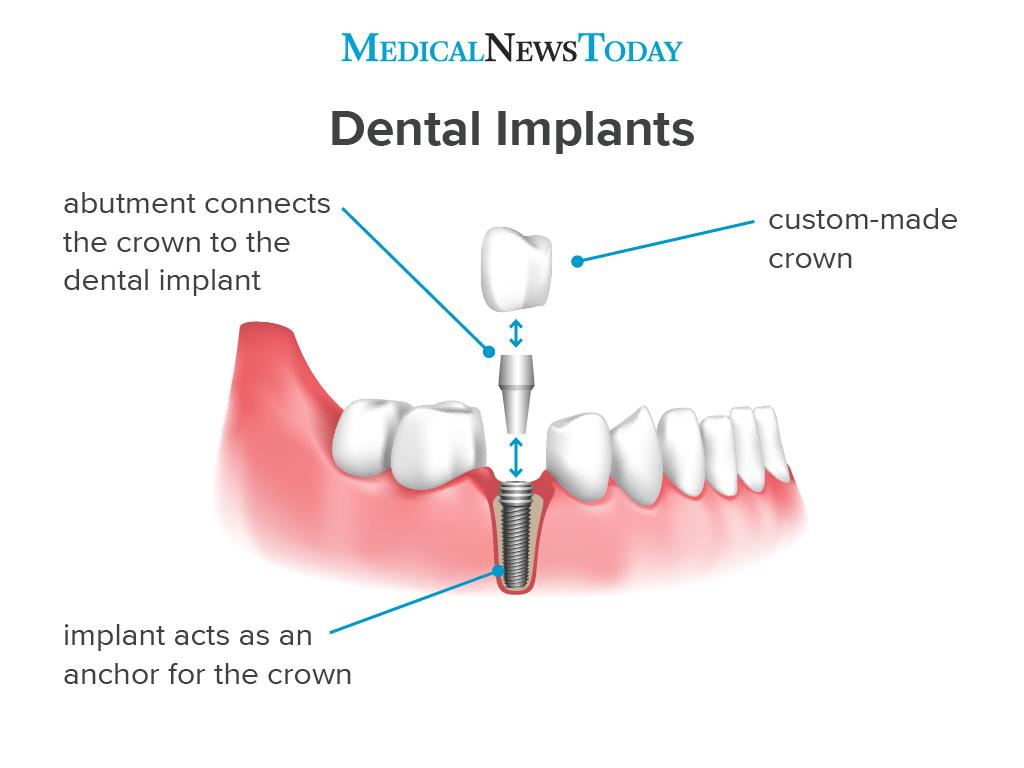3 Simple Techniques For Dental Implants
Table of ContentsSome Known Details About Dental Implants The 6-Minute Rule for Dental ImplantsNot known Incorrect Statements About Dental Implants Getting The Dental Implants To Work
are clinical devices surgically dental implanted into the jaw to recover an individual's capability to eat or their appearance. They offer assistance for synthetic (fake) teeth, such as crowns, bridges, or dentures. When a tooth is shed due to injury or disease, a person can experience problems such as fast bone loss, malfunctioning speech, or changes to eating patterns that result in discomfort.
Structure of The Oral Implant System selecting dental implants, talk with your dental supplier about the potential benefits and risks, and whether you are a prospect for the treatment. Things to think about: Your total health is an essential consider figuring out whether you are a great candidate for dental implants, how long it will take to heal, and the length of time the dental implant might remain in place.
Smoking might influence the recovery procedure and lower the long-lasting success of the dental implant. The recovery process for the dental implant body may take several months or longer, during which time you usually have a short-term abutment instead of the tooth. the oral implant treatment: Very carefully comply with the oral hygiene instructions provided to you by your oral service provider.
Excitement About Dental Implants
Implant failing can lead to the requirement for another operation to deal with or change the implant system. Brings back the ability to chew Restores aesthetic look Helps keep the jawbone from reducing due to bone loss Maintains the wellness of the surrounding bone and gums Aids maintain adjacent (nearby) teeth secure Enhances high quality of life Damage to bordering all-natural teeth during implant placement Injury to the surrounding tissues throughout surgery, such as sinus opening Injury throughout surgical treatment (for example, crack of bordering jawbone) Poor function, such as seeming like the teeth do not bite together typically A feeling that the tooth is loosened or turning in area resulting from an abutment screw loosening Implant body failure (looseness of the dental implant body) due to systemic infection, which might be most likely in patients with unrestrained diabetes mellitus as a result of local infection in bone and periodontals supporting the dental implant body as a result of postponed healing, which may be most likely in clients that smoke Trouble cleansing the periodontals around the implant, resulting in poor dental hygiene Untreated periodontal condition Post-surgical pins and needles due to nerve impingement or damages Always notify healthcare suppliers and imaging technicians that you have dental implants before any type of magnetic vibration imaging (MRI) or x-ray procedures.
FDA is not knowledgeable about any unfavorable events reported for MRI or x-ray procedures with oral implants. Dental implants systems are normally constructed from products that comply with worldwide consensus standards of the International Organization for Standardization (ISO) or ASTM International. These standards have information of what makes a secure product.
Oral dental implant systems are evaluated according to worldwide consensus criteria. Biocompatibility testing, to reveal that physical contact with the tool does not create problems like irritability or sensitive reaction, is part of the analysis that helps make certain the products in the oral important site implant system are secure and do not trigger damaging impacts when implanted in people.

5 Simple Techniques For Dental Implants
Some people are not eligible for oral implant surgical treatment. It is for dental doctors to operate on individuals with: intense illnessuncontrollable metabolic diseasebone or soft tissue illness or infectionIf these issues are fixed, an individual can have the surgery. Dental Implants. In, oral specialists avoid operating on people with: If individuals with any of the above undertake dental implant surgical treatment, there is a higher threat of the implant stopping working
Some individuals have a jawbone abnormality that stops enough bone for an implant from developing. In such situations, a cosmetic surgeon may need to execute a ridge adjustment. This involves lifting the gum to reveal the area More Bonuses of deformed bone. The doctor will after that use a bone or bone substitute to fix and develop up the area.
Oral dental implant surgical procedure is a personalized process. It's not the very same for everybody. The following provides a general review of what you can anticipate your dental expert, oral cosmetic surgeon, periodontist or prosthodontist to do: Position the dental implant Visit Your URL surgically. Give you time to recover. Connect the post and last crown, bridge or denture.
Next, your cosmetic surgeon will carefully put the dental implant right into your jaw. Ultimately, your specialist will reposition your gums and shut the incision with stitches. If your dental implant is near the front of your mouth, your dental practitioner will make a short-term tooth for you to wear till you recover. In this way, you won't have a space in your smile while you recoup.
An Unbiased View of Dental Implants
Throughout the healing stage, your jawbone must fuse to the oral implant. This process can take anywhere from 3 to 9 months.
As soon as your implant heals, your dental practitioner can affix the abutment (little adapter post) and your final restoration (crown, bridge or denture). This normally takes regarding one hour to complete and may need a second minor surgical treatment. You should not feel any type of pain throughout your oral implant procedure since your service provider will certainly make use of medicine to numb your gum tissues.